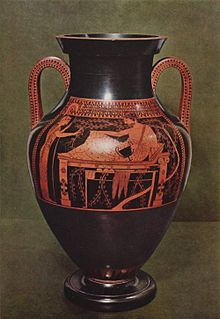Belly amphora of the Andokides painter (Munich 2301)
The belly amphora by the Andokides painter in the Staatliche Antikensammlung und Glyptothek in Munich (inventory number 2301) is one of the artist's best-known works and, as bilingue, is an important archaeological testimony to the transition from Attic black-figure vase painting to red-figure style . It is signed by the potter Andokides and was therefore made by him.
The Andokides painter is widely considered to be the inventor of the red-figure style of Greek vase painting. This was a reversal of the hitherto common style of black-figure vase painting. In the early stages of the red-figure style, both variants were used side by side, sometimes as with the abdominal amphora described here , both styles were used in windows on the front and back of vases. The special thing about this work by the Andokides painter was the representation of one and the same theme. So you can compare both styles with each other as an example. Shown is the most important hero of the Greek world of legends , Heracles . He is shown lying on a kline while drinking. In the black-figure variant, he is shown lying flat, holding the kantharos drinking vessel in his right hand . His gaze is directed towards the goddess Athena standing in front of him . Behind her stands Hermes with his winged shoes and traveling hat, behind him is a naked, somewhat small depicted servant who is busy with a large wine mixing vessel. In front of the kline is a table with pieces of meat, cakes and a kylix . A vine grows in the background, framing the scene between heroes and gods. His weapons are hung above Heracles.
The red-figure representation deviates in a few points from the black-figure representation, but otherwise reaches a different level of representation. The servant and the messenger of the gods Hermes are missing here, and the weapons cannot be seen either. Here, too, the scene is framed by the vine tendrils that not only grow out of the ground, but also twine and twist upwards. Herakles is no longer simply lying on his kline, but is shown with an erect upper body. To do this, he holds on to his knee with his hand. The two figures are shown more isolated than in the other picture. Overall, the composition seems much calmer and far more appropriate to an encounter between these two personalities. The kantharos - shown in black as in the other variant of the picture - is gaining in importance because it is now much more conspicuous. Athena gives Heracles a half-open flower. The blade overlay is now decorated with a careful meander pattern, as are the pillows and the border of the hero's robe. All in all, thanks to the interior drawings, the clothing looks far more precious than in the black-figure variant.
This amphora shows the design superiority of the red-figure style. The painter is given new, artistically far more extensive possibilities. The representations become more detailed. The 53.5 cm high and maximum 22.5 cm diameter amphora is dated to the period between 520/10 BC. The vase was found in Vulci . Some researchers assume that the black-figure drawing was made by the Lysippides painter . Other scientists equate this with the Andokides painter.
literature
- Michael Siebler : Greek art , bags, Cologne a. a. 2007, p. 46f. ISBN 978-3-8228-5447-1



